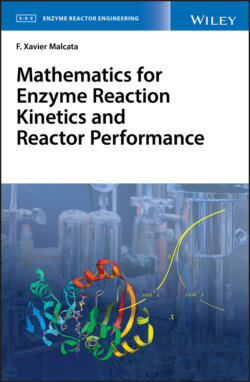Читать книгу Mathematics for Enzyme Reaction Kinetics and Reactor Performance - F. Xavier Malcata - Страница 34
2.4.1 Definition and Major Features
ОглавлениеThe two basic hyperbolic functions are the hyperbolic sine, sinh x, defined as
(2.472)
and the hyperbolic cosine, cosh x, abiding to
(2.473)
the plots of Eqs. (2.472) and (2.473) are provided in Fig. 2.14a. Note the even nature of cosh x, i.e.
(2.474)
with the aid of Eq. (2.473); in contrast to the odd nature of sinh x, according to
(2.475)
as per Eq. (2.472). The curves representing these two functions overlap at large x, i.e.
(2.476)
stemming from Eqs. (2.472) and (2.473), as emphasized in Fig. 2.14a (with the exact concept of limit coming soon); while there is a unit minimum value of cosh x at x = 0, viz.
(2.477)
based on Eq. (2.473) – with derivation rules to be introduced in due course.
Figure 2.14 Variation, with their argument x, of major hyperbolic functions, (a) hyperbolic sine (sinh) and cosine (cosh), (b) hyperbolic tangent (tanh) and cotangent (cotanh), and (c) hyperbolic secant (sech) and cosecant (cosech).
On the other hand, ordered addition of Eqs. (2.472) and (2.473), viz.
(2.478)
along with cancelation of symmetrical terms lead to
(2.479)
while ordered subtraction of Eq. (2.472) from Eq. (2.473) yields
(2.480)
since ex /2 cancels out with its negative – or simply
(2.481)
Equations (2.479) and (2.481) are expected, in view of cosh x being an even function and sinh x being an odd function – as per Eqs. (2.474) and (2.475), respectively, coupled with Eq. (2.1).
The remaining functions of practical interest include the hyperbolic tangent, tanh x, defined as
(2.482)
– at the expense of Eqs. (2.472) and (2.473), after dropping 2 from both numerator and denominator; as well as its reciprocal, the hyperbolic cotangent, cotanh x, according to
(2.483)
with the aid of Eq. (2.482) – both of which are depicted in Fig. 2.14b. Note the monotonically increasing pattern of tanh x, with
(2.484)
serving as leftward horizontal asymptote based on Eq. (2.482), complemented by
(2.485)
serving as rightward horizontal asymptote; along with the decreasing behavior of cotanh x, despite the discontinuity at x = 0, i.e.
(2.486)
stemming from Eq. (2.483) – which accordingly justifies why the vertical axis plays the role of vertical asymptote.
By the same token, the hyperbolic secant, sech x, abides to
(2.487)
after resorting to Eq. (2.473); while the corresponding hyperbolic cosecant, cosech x, looks like
(2.488)
once Eq. (2.472) is retrieved – and as plotted in Fig. 2.14c. When x approaches zero, the hyperbolic cosecant is driven by
(2.489)
arising from Eq. (2.488), so x = 0 plays the role of vertical asymptote for this function; as for the remaining values, cosech x monotonically decreases within]−∞,0[ and also within]0,∞[, as can be grasped in Fig. 2.14c. Conversely,
(2.490)
based on Eq. (2.487) – so the horizontal axis serves as horizontal asymptote toward −∞, whereas
(2.491)
indicates that the very same straight line serves as (horizontal) asymptote toward ∞. In this case, there is a maximum at x = 0 – since d sech x/dx = −2(ex − e−x)/(ex + e−x)2 (to be fully proven at a later stage) equals zero when ex = e−x, or else at x = 0; this critical point is easily perceived in Fig. 2.14c. Finally, note the resemblance between the functional form of Eqs. (2.482) and (2.483) with Eqs. (2.299) and (2.304), respectively – as well as between Eqs. (2.487) and (2.488), on the one hand, and Eqs. (2.309) and (2.314), on the other; this contributes to justify the denomination of (hyperbolic) trigonometric functions.
After squaring both sides of Eqs. (2.472) and (2.473), and then performing ordered subtraction of the result, one obtains
(2.492)
– where Newton’s binomial as per Eqs. (2.237) and (2.238) may be invoked to write
(2.493)
or, equivalently,
(2.494)
because ex e−x = ex−x = e0 = 1; after canceling symmetrical terms, Eq. (2.494) becomes
(2.495)
that readily simplifies to
(2.496)
– which reminds of Eq. (2.442) pertaining to circular functions proper (except for the minus sign). If Eqs. (2.472) and (2.473) are instead multiplied by one another, i.e.
(2.497)
one finds that
(2.498)
with the aid of the distributive property – or else
(2.499)
after lumping factors alike and canceling out symmetrical terms; if Eq. (2.499) is rewritten as
(2.500)
then comparison with Eq. (2.472) allows further reformulation to
(2.501)
that is equivalent to
(2.502)
– identical in form to Eq. (2.328), after setting x = y. This similarity further accounts for the extra labeling of trigonometric ascribed to the hyperbolic functions.
If Eqs. (2.472) and (2.473) are instead employed in parametric form, viz.
(2.503)
coupled with
(2.504)
one may square both sides of Eqs. (2.503) and (2.504) – and then proceed to ordered subtraction thereof to get
(2.505)
after factoring a2 out, Eq. (2.505) becomes
(2.506)
while insertion of Eq. (2.496) supports simplification to
(2.507)
Equation (2.507) is but the analytical equation of a hyperbola – thus backing up the hyperbolic designation for the functions under scrutiny.
Once in possession of Eq. (2.496), one may divide both its sides by sinh2 x to get
(2.508)
where insertion of Eqs. (2.482), (2.483), and (2.488) gives rise to
(2.509)
if both sides of Eq. (2.496) were instead divided by cosh2 x, one would have gotten
(2.510)
that degenerates to
(2.511)
after taking Eqs. (2.482) and (2.487) on board; the similarity of Eqs. (2.509) and (2.511) with Eqs. (2.469) and (2.471), respectively, is again striking – except for the minus, instead of plus sign.
